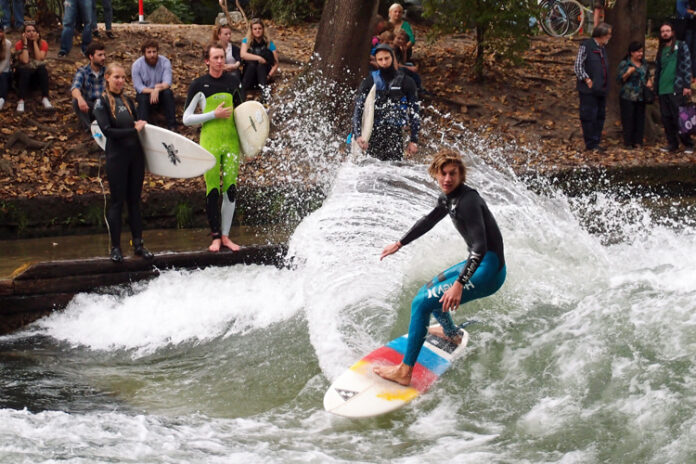Welcome to Eisbach, the birthplace of river surfing and probably the most famous wave in Central Europe.
The Eisbach is a 1.2-mile (two kilometers) river that flows across the Englischer Garten, a public park located in Munich, Germany.
Despite being a small distributary of the Isar River, the Eisbach features a very fast stream, making surfing a reality in an inland city.
The Eisbach wave is a stationary, human-made wave located just 50 yards away from the Haus der Kunst modern and contemporary art museum, in front of a nearby bridge.
The standing wave breaks in cold, 15-inch (40 centimeters) deep and 40-foot (12 meters) wide waters.
The surfing conditions at Eisbach vary depending on the weather and the time of the year, but it could produce a solid three-to-four-foot wave.
The best time of the year to ride Germany’s quintessential river wave is from March to November when water levels are not too high and not too low.
The average water temperatures range from 50 °F (10 °C) during summer to 62 °F (17°C) during the winter season.
Eisbach means “icy creek” or “ice brook” in English.
Although the Eisbach River wave rarely freezes due to its strong currents, it can easily reach extremely low temperatures of around 34 °F (1.1 °C).

The History of Eisbach Surfing
The origins of the world-famous Eisbach River wave date back to 1972, when a group of surfers rode it for the first time.
The German wave appeared almost overnight after the city submerged several concrete blocks under the bridge to block the strong river current.
In the early days, the Eisbach surf pioneers were only able to ride the wave in spring when the snow melted, and the water levels were high.
Dieter “The Eater” Deventer was one of them – and then came Wolfrik Fischer, Walter Strasser, Quirin Rohleder, Daniel Osswald, Tao Schirrmacher, and several other legendary surfers.
But the wave was still inconsistent, unstable, and sensitive to minor and subtle weather changes.
So, the Munich surfing trailblazers installed a few wooden planks that helped stabilize and improve the wave’s rideability.
The illegal construction works paid off, and the spot started providing year-round wave-riding opportunities.
But for several decades, surfing in Munich was a crime.
The local authorities only officially allowed surfing in Munich’s water channel in 2010.
Until then, riding a wave at Heimliche Hauptstadt – the “Secret Capital” – could get you into serious trouble with the police.
Actually, there was even a plan to destroy the wave and keep surfers away from the German waters.
However, a group of local enthusiasts ran a petition, created a website, and organized public river wave-riding awareness sessions to try to save the artificial surf break.
In the end, the authorities were sensitive to the community’s arguments and desire to make it a surfable wave and kept the spot intact.
There are a few rules that must be followed, though. A warning reads:
“The concrete baffles beneath the wave pose a risk of serious injury.”
“Due to forceful current, the Eisbach wave is suitable for skilled and experienced surfers only.”
“Only one person is allowed on the wave at a time. Surfing under the influence of alcohol or drugs is strictly prohibited.”


The Munich Surf Scene and Culture
Surfers dominate the popular Munich lineup, but kayakers, kneeboarders, and bodyboarders also ride the spot.
Despite its shallow waters, fins can be used on surfboards, as long as you pick a small setup.
There are rules that you must follow if you want to be accepted and respected at Eisbach.
Because there’s only one peak, you’ll have to queue in line, wait for your turn, and make sure you’ll not be surfing the wave for half an hour.
According to the informal code of rules, you have the right to surf the wave for as long as you can, but common sense should prevail.
So, just because you can, it doesn’t mean you should, so make sure to let others enjoy this natural treasure.
Consequently, the average ride lasts between 20 and 40 seconds, which will allow you to do a few turns and maybe a couple of airs, pop shove-its, and kickflips.
Is there localism at Eisbach? Yes, there is.
The spot even had a fierce superintendent – the “Hausmeister” – who once told Kelly Slater that he was not allowed to surf the German wave.
Also, only one person can ride the Eisbach at a time – party waves are not welcome and could result in injuries.

A Tricky Wave
The Eisbach River wave requires practice, training, and equipment changes.
A stationary wave is not an ocean wave, and Munich’s surf gem can be tricky and complex to master due to its fast-flowing characteristics.
Actually, the water flows at around 20 tons per second.
It all starts with an often challenging take-off, or step-off if you will.
And if you manage to get into the wave, be prepared for constant bumps and getting kicked out by the fast-flowing stream.
If you fall, be prepared for a more or less long hold-down in the turbulent whitewater washing machine just downstream.
At Eisbach, you don’t paddle into the wave – you jump onto it from both river banks.
The most common technique involves a small acid drop into the wave face, in a way similar to what can be done with a skateboard.
Back in the day, locals used to tie a rope to the bridge to hold onto and make surfing easier and sessions longer, but the practice was later prohibited as it was dangerous and potentially harmful.
In the past decades, the quality of the Eisbach River waves has incrementally been improved.
One of the upgrades was the attachment of ropes to the bridge, creating two U-shaped patterns that refined the wave’s breaking pattern and increased its height.
Today, the spot is often crowded. The waiting lines could be shorter during the cold season, though.
Also, at night, at around 11 pm, you might be able to surf German’s premier wave with no one else around.
The Eisbach features a fast and powerful current. Every year, people lose their lives swimming here. So, never ride the break all by yourself.


The Other Three Eisbach Surf Spots
Today, the Eisbachwelle is probably Germany’s ultimate surfing hotspot and one of the most popular tourist attractions in Munich.
But the city opened three additional river waves to allow more surfers to enjoy this thrilling experience.
There’s a second wider standing wave upstream near the Zum Flaucher beer garden that is perfect for beginner surfers.
It allows several simultaneous riders, but it usually only works from April to September when the Alpine snow melts and pushes extra water into the Isar River.
A third wide wave is available north of the original Eisbach wave, near the Englischer Garten.
The spot provides another great option for less experienced surfers thanks to its less powerful current and less demanding riding characteristics.
Last but not least, there’s a fourth Munich river wave popping near the Wittelsbacherbrücke bridge.
However, the spot can only be ridden a few days every year when the water levels are high, and the flood’s tree branches and dirt disappear.
A Unique Inland Surfing Experience
On their official website – eisbachwelle.de – the Munich surfing pioneers praise their beloved wave with nearly poetic words.
“The noise and roar of the Eisbach wave drown out everything. A fire brigade vehicle rushing past with sirens suddenly looks very far away,” the Eisbach surfers note.
“The roar of the spray is deafening. The current of the water catches the eye. Time seems to stand still. All the senses focus on just one thing – the wave.”
It’s easy to figure out why Eisbach means a lot to this hardcore group of inland surfers.
Munich is on the edge of the Alps and far from any coastline.
Suddenly, the landlocked city became known worldwide for something apart from Oktoberfest – surfing.
Surfer tourists from all over the world, big wave legends, world surfing champions, and professional surfers started booking tickets to Munich to experience this unique wave with the local crew.
In the 21st century, the spot was put on top of many surfers’ wishlists.
The Eisbach wave is constantly being surfed – 24/7, 365 days a year. It’s a natural machine that never stops.
“It’s probably the most ridden wave in the world,” add the Eisbach kaisers.
“Where else can you watch surfing so closely and be captivated by waves without getting very wet? This is the place where those who are not watching are surfing.”
Every year, locals try to improve the riding conditions somehow, always taking into consideration the two water channels that arrive separately from under the bridge.
The goal is to try and even the water levels coming from both channels.
“Keep Surfing,” a 2009 documentary by Bjoern Richie Lob, boosted Eisbach’s reputation as one of the most exciting river waves on the planet.
Words by Luís MP | Founder of SurferToday.com





